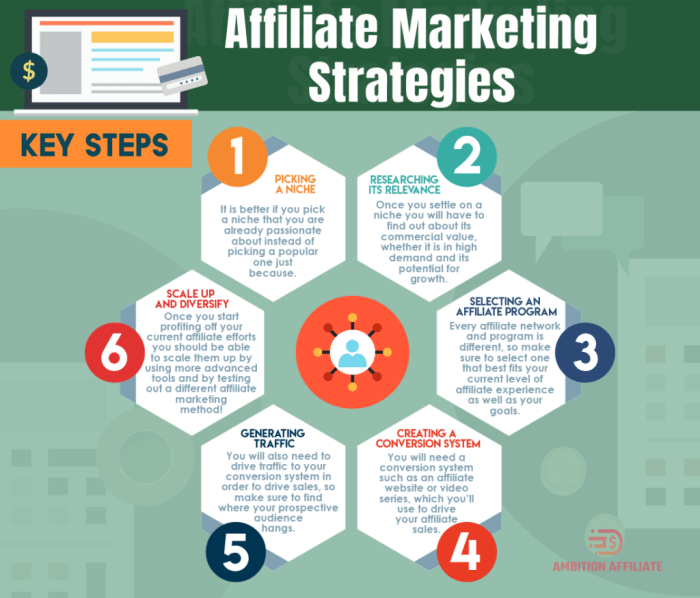Creating an Affiliate Marketing Strategy sets the stage for success in the digital landscape. From defining the strategy to engaging content creation, this guide will navigate you through the essentials of affiliate marketing.
Setting measurable goals, identifying target audiences, and selecting the right partners are just the beginning of your journey towards maximizing affiliate revenue.
Understanding Affiliate Marketing Strategy
An affiliate marketing strategy involves partnering with other businesses or individuals to promote your products or services in exchange for a commission on sales generated through their referrals. This strategy allows you to expand your reach and increase sales through the efforts of affiliates.
Having a well-defined affiliate marketing strategy is crucial for maximizing the effectiveness of your program. It helps you set clear goals, identify target audiences, select the right affiliates, and establish commission structures. A well-thought-out strategy ensures that your program is aligned with your overall marketing objectives and helps you track performance and optimize results.
Examples of Successful Companies Utilizing Affiliate Marketing Strategies
- Amazon: One of the largest e-commerce companies, Amazon, has a robust affiliate marketing program that allows individuals to earn commissions by promoting products on their websites or blogs. This has contributed significantly to their sales and brand visibility.
- Shopify: The e-commerce platform Shopify offers an affiliate program where partners can earn commissions for referring new customers. This has helped Shopify grow its user base and increase revenue.
- Bluehost: As a web hosting company, Bluehost has a successful affiliate program that incentivizes affiliates to promote their hosting services. This has been instrumental in driving customer acquisitions for Bluehost.
Setting Goals for Your Affiliate Marketing Strategy

Setting realistic goals for your affiliate marketing strategy is crucial for success. It involves identifying what you want to achieve and outlining specific targets to work towards. By setting measurable goals, you can track your progress and make adjustments as needed to improve performance.
Examples of Measurable Goals
- Increase website traffic by 20% within the next three months.
- Achieve a 10% conversion rate on affiliate links by the end of the quarter.
- Generate $1000 in affiliate revenue per month.
Significance of Aligning Goals with Business Objectives
Setting affiliate marketing goals that align with your overall business objectives is essential for ensuring that your efforts drive meaningful results. By connecting your affiliate goals to the broader goals of your business, you can maximize the impact of your marketing strategy and contribute to the growth and success of your company.
Identifying Target Audience

Identifying your target audience is crucial for the success of your affiliate marketing strategy. Understanding who your potential customers are will help you tailor your promotions and content to better resonate with them, ultimately leading to higher conversion rates and increased sales.
Methods to Research and Define the Target Audience, Creating an Affiliate Marketing Strategy
- Conduct market research to gather information about demographics, interests, and behaviors of your target audience.
- Use analytics tools to track website visitors and social media interactions to identify patterns and preferences.
- Create customer personas based on your research to visualize and understand your target audience better.
- Solicit feedback from existing customers to gain insights into their needs and preferences.
Impact of Understanding the Target Audience on Affiliate Marketing Strategy
- Improved targeting: By knowing your audience, you can tailor your content and promotions to match their interests and needs, leading to higher engagement and conversion rates.
- Effective communication: Understanding your audience’s language and communication style allows you to craft messages that resonate with them and build trust.
- Increased ROI: Targeted marketing efforts are more likely to yield positive results, maximizing your return on investment in affiliate marketing.
Selecting Affiliate Programs and Partners: Creating An Affiliate Marketing Strategy
When it comes to selecting affiliate programs and partners, it’s crucial to choose wisely to maximize your earning potential. Here are some criteria to consider and a checklist to help you evaluate potential affiliate programs and partners.
Criteria for Selecting the Right Affiliate Programs and Partners
- Relevance: Make sure the products or services offered by the affiliate programs align with your target audience’s interests.
- Commission Structure: Look for programs that offer competitive commission rates and fair payment terms.
- Quality: Partner with programs that provide high-quality products or services to maintain your credibility with your audience.
- Support: Check if the affiliate programs offer adequate support and resources to help you succeed in promoting their products.
- Track Record: Research the reputation and track record of the affiliate programs to ensure they are reliable and trustworthy.
Checklist for Evaluating Potential Affiliate Programs and Partners
- Review the products or services offered and assess their relevance to your audience.
- Examine the commission structure and payment terms to ensure they are fair and beneficial for you.
- Investigate the quality of the products or services to maintain your audience’s trust in your recommendations.
- Inquire about the support and resources provided by the affiliate programs to help you achieve success.
- Check the track record and reputation of the programs to ensure they are reputable and reliable partners.
Benefits of Establishing Strong Relationships with Affiliate Partners
- Increased Trust: Building strong relationships with affiliate partners can lead to increased trust from your audience, making them more likely to purchase the products you recommend.
- Collaborative Opportunities: Strong relationships can open up opportunities for collaboration, such as exclusive promotions or joint ventures, that can benefit both parties.
- Long-Term Success: By nurturing strong relationships with affiliate partners, you can create a foundation for long-term success and sustainable income streams.
- Support and Resources: Affiliate partners who value the relationship may provide additional support and resources to help you optimize your marketing efforts and maximize your earnings.
- Mutual Growth: Strong relationships with affiliate partners can lead to mutual growth and success as you work together to achieve common goals and objectives.
Creating Compelling Content and Offers
To stand out in affiliate marketing, it’s crucial to create content that not only catches the eye but also resonates with your target audience. Here are some tips for creating engaging content that drives conversions:
Types of Offers in Affiliate Marketing
- Discounts and promotions: Everyone loves a good deal, so offering discounts or running special promotions can entice your audience to make a purchase through your affiliate link.
- Freebies and giveaways: People are drawn to free stuff, so offering freebies or hosting giveaways can attract more clicks and conversions.
- Limited-time offers: Creating a sense of urgency by promoting limited-time offers can encourage your audience to take action quickly before the opportunity passes.
Optimizing Content and Offers for Maximum Revenue
- Understand your audience: Tailor your content and offers to meet the needs and preferences of your target audience for better engagement and conversion rates.
- Use compelling visuals: Incorporate eye-catching images, videos, and graphics to make your content more visually appealing and memorable.
- Include strong calls-to-action (CTAs): Encourage your audience to take the desired action by using clear and persuasive CTAs that guide them towards clicking on your affiliate links.
- Track and analyze performance: Monitor the performance of your content and offers to identify what works best and optimize your strategy for maximum revenue generation.